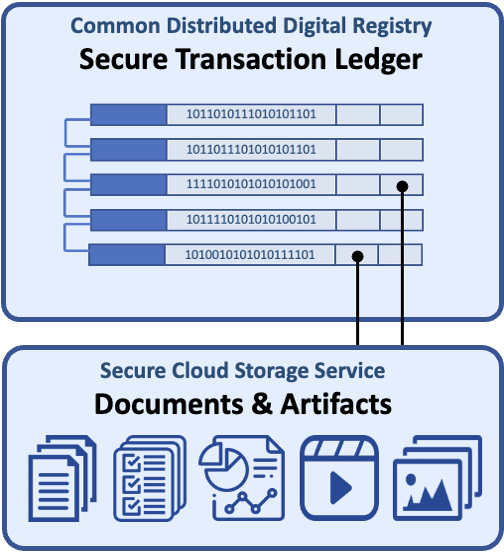A Blockchain Primer for Carbon Markets
What is Blockchain, and why is it useful for Carbon Credits?
Building a trusted, transparent, and traceable marketplace for carbon credits while resisting the manipulation and fraud seen in other voluntary markets will require establishing a verifiable source of truth for all transactions. Blockchain, despite its limitations, is a potentially useful technology in developing a robust and scalable solution to underpin the market for carbon credits.
It may seem odd that a technology so closely associated with volatile and fraudulent markets such as cryptocurrencies and NFTs could be part of such a solution. To understand why requires looking past the over-hyped, simplistic and often flawed implementations of blockchain for cryptocurrencies and NFTs and examine the use and capabilities of the underlying technology.
As Doug Johnson-Poensgen of Circulor, one of the early implementers of blockchain for enterprise-grade solutions, puts it, “blockchain is a very good ledger but a very bad database”. This observation is key to recognizing how blockchain can fit within a marketplace solution for carbon credits.
figure 01: distributed cryptographically-secure digital ledger
What is Blockchain? A blockchain is fundamentally a technology which enables the creation of a distributed cryptographically-secure digital ledger (see figure 01). This means that once transactions are recorded in the ledger they cannot be readily changed or altered. Access to the ledger can either be fully public or restricted to authorized users, and all authorized users can see a verified version of the same ledger.
When implemented properly, a blockchain can provide a robust, secure registry of all transactions conducted within a system. The nature of the ledger means the history of every asset registered in the system can be traced, including the time, value, and parties involved in each transaction. The inability to change this information is key to establishing trust in the contents of the digital ledger.
What are the limitations of Blockchain? Like any technology, the strengths and weaknesses of blockchain require the information architecture of any system using it to be carefully designed to ensure the integrity of the data and minimize the potential for corruption or loss.
In comparison to a database, adding information to a blockchain is slow and expensive. The cryptographic process to add an entry and then replicate it across multiple nodes requires significant electricity and computing power, even for private blockchains. In addition, the amount of data able to be included in a blockchain is limited, so larger files or documents , such as images, scans, videos, and documents being stored “off-chain” in databases or other secure data repositories and linked to from the on-chain record. For example, NFTs often contain a pointer to a location on the IPFS file-sharing system where the “art” is actually held.
Enterprise-level solutions such as carbon market applications also require the implementation of robust business processes which define the way in which users interact with the system and data. While some blockchain products incorporate the concept of smart contracts or other forms of “logic layers”, these are not as mature as established software platforms and may not be suitable for implementing the level of interaction and usability required.
An additional level of complexity comes when the identity of individuals transacting on the blockchain must be verified, for example an inspector digitally signing a certificate attesting to the status of an entry in the ledger. The actions of each user recorded in the ledger is a combination of their role in the business process and their authorization to conduct a particular transaction. Blockchains inherently don’t have a method of identity verification, so this is another activity which needs to occur “off-chain”.
Why Blockchain can be useful for Carbon Markets solutions.
figure 02: example of possible carbon market technology stack
As outlined above, the model carbon market outlined above includes an initial technology stack (see figure 02) which includes blockchain along with other technologies. Focusing on blockchain’s utility as a secure, distributed ledger within the overall architecture of a carbon market solution retains the strengths of the technology as a secure distributed ledger while not attempting to use it for purposes where it is poorly suited.
Elaborating on this, we can start to develop a solution architecture which begins to capture the user personas, business process domains, and data elements in a coherent way. This can be further expanded into the technical architecture, software architecture, and information architecture tailored to the specific business processes and compliance requirements of the specific applications.
As the secure, distributed ledger of transactions, blockchain forms a core part of this example architecture for a carbon market solution (see figure 03). However, blockchain alone is not sufficient to provide a robust, scalable, and trusted marketplace and needs to be combined with other technologies in order to deliver a complete solution.
figure 03: example architecture of a digital carbon market
If you would like to know more about carbon offsets and creating a comprehensive decarbonization strategy, please contact info@deepblue.institute. The Deep Blue Institute is committed to working with businesses, innovators, communities, and activists to architect lasting sustainable solutions to the world’s most complex challenges. Discover more at www.deepblue.institute or check out The Blue Economy Primer podcast.
Author:
Liam Speden
Senior Advisor; Deep Blue Institute
Liam is an experienced business leader with over 25 years’ experience shaping and implementing transformative business solutions which deliver innovation and improved performance in both public and private sectors.
If you enjoy this article, please consider supporting Deep Blue Academy’s non-profit education and research work by making a tax deductible donation today.






